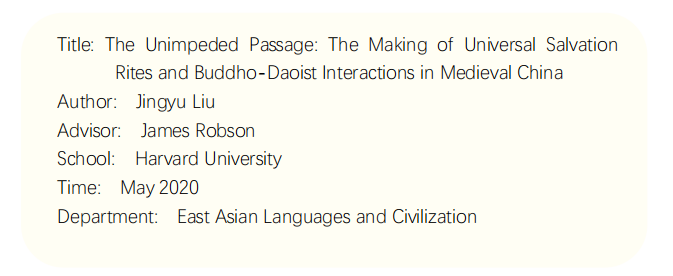
Abstract:This dissertation probes the interactive relationships between Buddhism and Daoism in terms of their liturgical exchanges. I focus on the prominence of a special ritual known as “universal salvation” (pudu普度) between the twelfth and fourteenth centuries. Aiming at bringing about the deliverance en masse of the souls of the dead and conferring blessings upon the living regardless of age, gender, or social status, universal salvation rites gained increasing prominence in the twelfth century and are still practiced nationwide in contemporary China as well as in some diasporic Chinese communities. My study is the first to investigate how liturgical interactions among various religious traditions, Buddhism and Daoism in particular, gave rise to the popularization of two similar yet competitive universal salvation ceremonies known as the Water-Land Retreat (Shuilu zhai水陸齋) in Buddhism and the Yellow Register Retreat (Huanglu zhai黃籙齋) in Daoism. Although there have been many studies on the shift from doctrinal studies to ritual studies, there remain paucity of studies on Chinese religions that have explored specific cases concerning that shift in focus. Therefore, my dissertation
provides a comprehensive case analysis and demonstrates a new model for how to better understand Chinese religious culture. Furthermore, my research shows that the universal salvation rites included seemingly contradictory yet compatible religious elements, such as self-cultivation and merit-transfer, public trial and divine amnesty, spiritual enlightenment and worldly welfare. I argue that the formation of universal salvation rites did not come from a direct “face-to-face”Buddho-Daoist interaction but grew out of a socio-religious repertoire in which Buddhist, Daoist, Confucian, and other religious elements were intermixed.What undergirded this repertoire was a contractual, numerical/mathematical, and bureaucratic historical context that is intrinsic to Chinese culture. By writing the history of a given ritual practice and by understanding its meaning in a sociopolitical context, my study constructs a socio-liturgical matrix that sheds light on the reassessment of the complexity of the Chinese religious landscape and its social history.
>>論文全文
![]() Jingyu Liu_The Unimpeded Passage_without DAC.pdf
Jingyu Liu_The Unimpeded Passage_without DAC.pdf
返回列表


